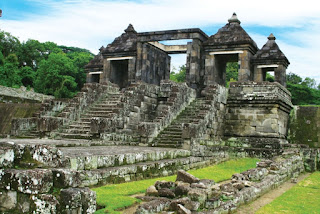RATU BOKO PALACE,Yogyakarta's Tourism
RATU BOKO PALACE
Ratu Boko (Javanese: Ratu Baka) or Ratu Boko Palace is an archaeological site in Java. Ratu Boko is located on a plateau, about three kilometres south of Lara Jonggrang Prambanan temple complex in Yogyakarta, Indonesia. The original name of this site is still unclear, however the local inhabitants named this site after King Boko, the legendary king mentioned in Loro Jonggrang folklore.[1] In Javanese, Ratu Baka means "Stork King".
The site covers 16 hectares in two hamlets (Dawung and Sambireja) of the village of Bokoharjo and Prambanan, Sleman Regency. In striking contrast to other Classic-period sites in Central Java and Yogyakarta, which are remains of temples, Ratu Boko displays attributes of an occupation or settlement site, although its precise function is unknown.[2]Probably the site was a palace complex which belonged to the kings of Sailendra or Mataram Kingdom that also built temples scattered across the Prambanan Plain. The argument was based on the fact that this complex was not a temple nor building with religious nature, but a fortified palace instead which evidence of a remnant of fortified walls and the dry moat of defensive structures.[3] The remains of settlements also founds in Ratu Boko vicinity. This site is located 196 m above the sea level, on the highest point in the site, there is a small pavilion from which one will be able to see a panoramic view of Prambanan temple with Mount Merapi as the background.
History
According to writer HJ. DeGraff, in the 17th century there were many European travelers to Java, who mentioned that there existed an archeological site which related to certain King Boko. In 1790, a Dutch researcher, Van Boeckholtz was the first to discover the archaeological ruins on top of Ratu Boko Hill. The hill itself is the northwestern branch of a larger Sewu mountain system, located on southern part of Central and East Java spanned between Yogyakarta to Tulungagung. The publication of the discovery attracted scientists such as Mackenzie, Junghun and Brumun to conduct research and exploration on the site in the year 1814. In the early 20th century, the Ratu Boko site was thoroughly studied by researcher FDK Bosch, who published his findings in a report entitled "Keraton Van Ratoe Boko". From this report concluded that the ruins was the remnant of a keraton (palace). During these researches, Mackenzie also found a statue of gold-headed man and woman embracing each other. A stone pillar with ornaments of zoomorphic figures among which are elephants, horses, and others, also found among the ruins.[1]
Abhayagiri Vihara inscription dated 792 CE is one of the few written evidence discovered in Ratu Boko site. The inscription mentioned Tejahpurnapane Panamkarana or Rakai Panangkaran (746-784 M), and also mentioned a vihara located on top of the hill called Abhyagiri Wihara which means "a vihara on top of the hill that free from danger". From this inscription it was concluded, that King Panangkaran in a later period of his reign wished for a spiritual refuge and created a reclusion of Buddhist hermitage named Abhayagiri Wihara in 792.[1] Rakai Panangkaran was a pious follower of Mahayana Buddhist, a Dhyani Buddha statue was discovered on the site, which confirmed its initial Buddhist nature. Nevertheless, some Hindu elements are also found at the site, such as the discovery of statues of Hindu deities: Durga, Ganesha and Yoni.
It seems that the compound was later converted to a hilltop fortress by a local landlord named Rakai Walaing Pu Kumbayoni. According to the Shivagrha inscription, the place was used as a defensive fort, consisting of hundreds of stacked stones. The hilltop fortress was used as a fort during a power struggle in later days of Mataram Kingdom.
The Ratu Boko complex consists of gopura (gates), paseban, pools, pendopo, pringgitan, kaputren (women's quarter), and meditation caves.
Source : Wikipedia






Comments
Post a Comment